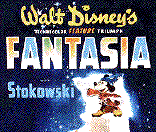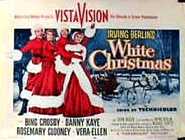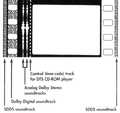
1935 WPA film We Work Again,
National Archives.
 1935 WPA film We Work Again, National Archives. |
1935 - Douglas Shearer at MGM developed a two-way speaker system that became standard in theaters for the next 20 years. This system used a multicellular high-frequency horn and a low-frequency section of 15-inch woofers. MGM first installed the speakers in the New York Loew's 5000-seat Capitol Theater on Broadway for the premier of Romeo and Juliet. To make components, MGM turned to the Lansing Manufacturing Co. in Los Angeles that grew into the Altec Lansing Co. by 1941 and JBL in 1955, the industry leader in motion picture loud speakers. The Shearer-Lansing system won an Academy award in 1936 for technical excellence. (see A Brief History of James B. Lansing by John Eargle)
 |
1937 - The film One Hundred Men and a Girl starring Deanna Durbin was released by Universal in standard monophonic sound, but it was the first film soundtrack originally recorded by RCA in the "Multiple Channel Recording" process that had been developed by Bell Labs and RCA since 1932 at the Philadelphia Academy of Music. The songs of Durbin and the orchestra of Leopold Stokowski were recorded on 9 channels, each channel printed optically on 35mm motion picture film. The 9 channels were then edited in Hollywood into one channel for the optical soundtrack on edge of the release prints. The same recording process would be used in 1940 for Disney's Fantasia.
1940 - Nov. 13 premier of Walt Disney's Fantasia in New York's Broadway Theater with a multichannel soundtrack produced by Leopold Stokowski who recorded an optical track for each section of the orchestra, resulting in 9 separate soundtracks.

|
1952 - This is Cinerama premiered Sept. 30 at the Broadway Theater in New York and would play for 122 weeks. This 3-projector system designed by Fred Waller
 |
1953 - The Robe premiered Sept. 16 at the Roxy in New York in Cinemascope by Twentieth Century Fox with 4-track magnetic soundtrack on the edge of each 35mm cellulose tri-acetate film strip (allowing smaller sprocket holes than weaker nitrate film, and more room for the soundtrack). The Cinemascope technique used an anamorphic lens to film and project a wide image on a curved screen 64 1/2 ft. wide and 26 1/2 ft. high, with three speakers behind the screen (see Cinemascope at American WideScreen Museum)
1954 - White Christmas released April 27 in Paramount's VistaVision horizontal 35mm widescreen format with Perspecta sound. "Perspecta employed a
 |
1955 - Oklahoma! premiered Oct. 10 at the Rivoli Theater in New York in 65mm Todd-AO with a separate 6-track magnetic soundtrack system designed by Westrex and Ampex, running at 90 ft. per minute (24 fps) in synch with the film projector running at 112.5 ft. per minute (30 fps).
 |
 |
Image at left from 1955 newspaper ad
for the Cinemascope version of Oklahoma! that was filmed at the same time
as the experimental Todd-AO version and was exhibited in theaters not equipped
with Todd-AO equipment. The 1994 laserdisc restoration of Oklahoma! used
the Todd-AO version with some scenes filmed differently than the Cinemascope
version. From 1950s to 1970s, expensive 70mm films used 6-track magnetic
soundtrack 5mm wide placed on the filmstrip between the image and the
sprocketholes.
1967 - The Graduate became on of the first films to use old songs from records as a major part of its musical soundtrack. The songs were taken from earlier LPs by Simon and Garfunkel. The song "Mrs. Robinson" was the only original tune but sung in the film only in fragments. Later, the full version was composed and recorded for the soundtrack album, and became the first popular song that mentioned "Jesus" by name, and some radio stations would not play it. See Paul Simon - Now and Then by Spencer Leigh, 1973, from The Graduate Soundtrack. The technique of using popular records in film soundtracks would become standard practice in the 1970s after the success of nostalgic films such as American Graffitti in 1973.
1970 - November - Dolby A-type noise reduction, developed in 1965 by Ray M.
Dolby, was tested on the film Jane Eyre
1971 - A Clockwork Orange, the first film to be mastered with Dolby noise reduction, released in December with conventional optical soundtrack; 3 months later the Dolby Model 364 cinema unit was introduced to decode optical soundtracks that contained A--type noise reduction. Image at right of Alex from the Kubrick page by Patrick Larkin - also poster
1974 - Earthquake premiered Nov. 15 in the Chinese Theater in
Hollywood with Universal Picture's Sensurround process developed by W. O. Watson
and Richard Stumpf at Universal. Four large low-frequency horns were located
behind the screen, two in each corner. The Model W horn in each corner was 8 ft.
long, 4 ft. wide, 4 ft. high. The Model C horn in each corner was a modular unit
1 ft. wide and 5 ft. high. Two additional horns were located on a platform in
the rear of the theater.  Each horn was
driven by a 1000-watt amplifier controlled by inaudible tones on a special
optical control track along with the normal 4-track magnetic soundtrack of the
35mm Panavision filmstrip. These films could only be played with
Sensurrond-equipped projectors. Normal 4-track magnetic projectors could play
the soundtrack but not the Sensurround effects. A 35mm optical print was
released with monophonic sound and included the control signals to activate the
special speakers if they were installed in the theater. Some prints released in
Europe and Japan were 70mm with 6-track magnetic soundtracks using tracks 2 and
4 for the control signals. The tones turned the horns on and off at preset
volumes, creating low-frequency vibrations 5-40 cycles at sound pressures of
110-120 db, causing the audience, chairs, floor to "feel" the vibrations of the
earthquke and dam destruction scenes. Image at left from the Nov. 1974
American Cinematographer diagram for
Sensurround
Each horn was
driven by a 1000-watt amplifier controlled by inaudible tones on a special
optical control track along with the normal 4-track magnetic soundtrack of the
35mm Panavision filmstrip. These films could only be played with
Sensurrond-equipped projectors. Normal 4-track magnetic projectors could play
the soundtrack but not the Sensurround effects. A 35mm optical print was
released with monophonic sound and included the control signals to activate the
special speakers if they were installed in the theater. Some prints released in
Europe and Japan were 70mm with 6-track magnetic soundtracks using tracks 2 and
4 for the control signals. The tones turned the horns on and off at preset
volumes, creating low-frequency vibrations 5-40 cycles at sound pressures of
110-120 db, causing the audience, chairs, floor to "feel" the vibrations of the
earthquke and dam destruction scenes. Image at left from the Nov. 1974
American Cinematographer diagram for
Sensurround
1974 - November - Dolby Labs demonstrated the first 35 mm Dolby Stereo
optical soundtrack on a section of the film, Stardust, at the Society of
Motion Picture and Television Engineers (SMPTE) convention in Toronto; the Dolby
Stereo 4-channel optical stereo variable area (SVA) was encoded with left,
middle, right, and surround channels that became the ISO 2969 standard for
motion picture soundtracks, and was the origin of home consumer versions later
known as Dolby Surround and Dolby Pro Logic.
1975 - Nuoptix developed an Anticipatory Noise Reduction system for its FR-1 Optical Sound Recording System that was adopted by Hollywood studios to produce optical soundtracks. The system was also sold by Westrex, the former sound and motion picture equipment distributor of Western Electric.The system evolved to use digital audio delay technology for the anticipatory noise reduction and became the worldwide standard system for recording Dolby stereo optical sound tracks.
1975 - March premier in London of the film Tommy, with a Dolby Stereo
soundtrack played on the Dolby CP100 Cinema Processor designed to decode
magnetic and optical soundtracks.
1975 - September - Lisztomania released as the first feature film with
a Dolby Stereo optical soundtrack.
1976 - Spring - A Star Is Born released with surround sound effects
encoded in the Dolby Stereo optical track.
1977 - May - Star Wars released in 46 U.S. theatres equipped for Dolby
Stereo; Star Wars next spring won the Academy Award for Best Achievement
in Sound.
1979 - November - Apocalypse Now released in 15 theaters equipped to
play the first Dolby Stereo 70 mm film with surround sound.
1981 - August - Inauguration of Music Television (MTV) in stereo with B-type
noise reduction; Dolby B was developed 1968 and used in FM broadcasting after
1971 and in consumer electronics, but did not replace the professional A-type
used in motion pictures.
 |
1982 - Return of the Jedi was the first movie exhibited on the THX
sound system designed by George Lucas and Tomlinson Holman; THX "is comprised of
customized acoustical design work for each auditorium, a special screen speaker
installation method, a proprietary electronic crossover network, and rigorous
audio equipment specifications and performance standards." (quote from Overview, Lucasfilm THX Theater
Sounds Systems page)
1985 - January - VH-1, the 2nd music tv channel, distributed by satellite
using the digital process kown as Dolby AC-1
1986 - Dolby SR (spectral recording) optical format demonstrated to the Academy of Motion Picture Arts
 |
1987 - July - Innerspace and Robocop released in Dolby Stereo
SR
1988 - The IMAX digital sound system was developed by Sonics Associates of Birmingham, Alabama. Sonics was founded in 1971 by Lynn McCroskey and Jim Cawhon who began in the early 1980s to develop a sound system for the IMAX theater at the U.S. Space & Rocket Center in Huntsville. By 1988, they developed a Digital Disc Playback system (DDP) that recorded 2 channels of uncompressed digital sound on an audio compact disc. This system with 3 discs and 6 channels began to replace the multitrack magnetic tape sound systems used in IMAX theaters since 1971. In 1993, Sonic introduced the IMAX 3D sound system with 10 channels for the Sony IMAX theater in New York. Theater speakers produce 8 channels from 4 CD disks synchronized with the15-perforation 70 mm filmstrip running through the projector horizontally past a 15,000-watt lamp at 48 frames per second. The 3D headset has 2 additional channels for the binaural Personal Sound Environment (PSE).
1990 - Dick Tracy released June 15 as the first 35mm feature film distributed with a digital soundtrack by Cinema Digital Sound (CDS), developed by Eastman Kodak and Optical Radiation Corp. "The system was set up in the typical Left, Center, Right, Right Surround, Left Surround, LFE channel format. CDS encoded 16-bit PCM audio in a compression process called Delta Modulation. The process is very similar to normal PCM coding, but with one major difference. PCM coding records the intensity of every sample to a zero db level. That requires 16-bits for each sample. Delta Modulation records the intensity differences of successive samples, and that doesn't require nearly as much data. The compression level of CDS ran approximately 4:1." (quote from Bobby Henderson, CDS) However, the system replaced the optical analog soundtrack without allowing any backup track for theaters not equipped with the $20,000 digital playback system. Also, theaters preferred to wait for the Dolby digital system that was compatible with an analog track.
 |
 |
 |
 |
| IMAX DDP | Dolby SR-D | DTS | Sony SDDS |
| introduced 1988 | introduced 1991 | introduced 1993 | introduced 1993 |
| by Sonic Associates | by Dolby Laboratories | by Digital Theater Systems | by Sony Electronics |
 |
1992 - Batman Returns premiered June 19 in 10 theatres equipped with
new Dolby DA10 Digital Film Sound Processor
1993 - Jurassic Park released May 30 as the first film with DTS sound, developed by Terry Beard, founder of Digital Theater Systems in Westalke Village, CA, partly owned by Steven Speilberg and Universal Pictures. This digital sound film format records 6 tracks on separate CD-ROM disks, synchronized by an optical timecode track recorded on the film, co-existing with a backup optical soundtrack similar to Dolby Stereo.
 |
1993 - Last Action Hero released July 18 using the Sony Dynamic
Digital Sound (SDDS) digital sound film format that put 6 or 8 tracks of digital
sound on 2 optical stripes on each edge of the film strip, recorded on the cyan
layer beneath the other emulsion layers, using the lossy ATRAC algorithm of the
Sony Minidisc
technology with a compression ratio of 5:1, dynamic range of 105db and a
frequency response from 5-20,000Hz. It is compatible with a backup standard
optical soundtrack such as Dolby SR.
 |
1996 - DTS trailer film for Jurassic Park: The Lost World released:
"The teaser trailer, which debuted on December 13 at forty locations in the
United States and two in Toronto, Canada, is driven by a modified DTS that
activated six stategically placed strobe lights employed to comlement the images
that appear on the screen. Using DTS technology, the timing for the strobe
lights is encoded into the trailer's print, which is synched to the highly
reliable DTS CD-ROM system. Audiences viewing the teaser trailer feel as if they
are caught in a rainstorm complete with life-like sound and lightning provided
by the strobe lights." (press release from DTS).
1996 - The English Patient was the first Oscar-winning American film with a digitally edited soundtrack, winning Walter Murch two Academy Awards for film and sound editing.
1998 - Dolby became the leading producer of motion picture sound processors used in theaters worldwide with over 50,000 sold; projector attachments such as the CP500 digital cinema processor introduced in 1995 were capable of decoding 2 of the 4 soundtracks recorded on most film prints (see chart at right from Audio).
 |
1998 - The Last Broadcast premiered Oct. 19 as "the first desktop feature film" produced and exhibited digitally, co-sponsored by Texas Instruments using its DLP digital cinema projector.
1999 - Star Wars: Episode I - The Phantom Menace was released May 19 in the U.S. with Dolby Digital Surround EX providing an added rear center audio channel. On June 18, it was the first major studio motion picture to be exhibited in digital cinema in 4 theaters with digital projectors by Texas Instruments and by CineComm.
2000 - Jan. 1 Disney released Fantasia/2000 in the IMAX film format with 6-channel digital sound.
|
|